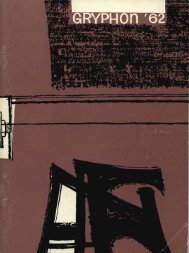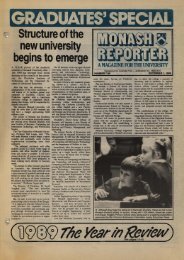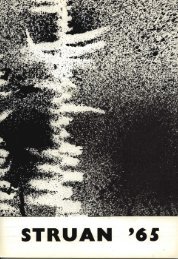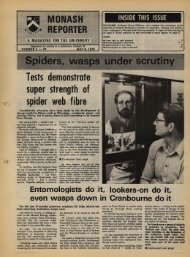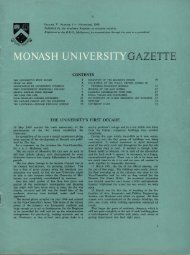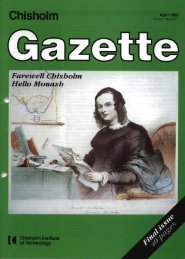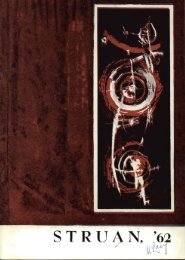MONASH UNIVERSITY GAZETTEthat it can be studied in its functioning state.(iii) The Epidermis and Cuticle: The aerial parts ofvascular plants are covered by a continuous layer ofcells, the epidermis, whose outer walls are thick andcovered with a cuticle (see Fig. 3). The cuticle is similarin properties to a coat of paint, covering the epidermalcells with a thin waterproof skin that acts as abarrier to water loss or entry. The same layer alsohelps to protect the photosynthetic cells, that lie beneathit, from attack by pathogens. The continuity of theepidermis is interrupted by stomata, pores whose apertureis controlled by the special guard cells that surroundthem (Fig. 4). When the pores are open, carbondioxide and oxygen can exchange from the atmospherewith the gas lining the photosynthetic cells, permittingphotosynthesis. These same pores allow loss of watervapour when they are open, a loss made good by thetranspiration stream. In many plants the cuticle isimpregnated with wax which makes it even more waterproof.You will have noticed this waxy deposit on theleaves of young blue gums or cabbages. It is alsoently unrelated problems. The truth of the matter is thatthe techniques and approaches found useful in one projectwill assist the rate of progress upon the otherprojects, for so many of the technical problems to beovercome in this research programme are common toall cell biology. It is my hope that this approachwill rapidly advance our understanding of man's mostimportant group of crop plants.SPORTS CENTRE PUBLISHESBOOKLETA booklet on the emergency treatment of sportsinjuries has been produced by the committee of the<strong>Monash</strong> Sports Medicine Centre. It illustrates the valueof the inter-disciplinary approach to sports medicine.The booklet was produced for the Sports Associationby the members of the Sports Medicine Centre in orderto meet a community need.With the aid of a grant of $1,500 from the RothmansNational Sport Foundation to cover the cost of publicationabout 20,000 copies have been printed. These arebeing distributed free throughout the Commonwealth.It is hoped that the booklet will provide simplepractical information for anyone who may be askedto give first aid for sporting injuries, when trainedmedical or first aid people are not present.Mr A. H. Toyne, the secretary of the AustralianSports Medicine Association, said: 'The booklet's mainvalue is that it shows untrained people how to giveexpert first aid.'Fig. 4. Surface view of epidermis of a pea leaf, showingthe wavy outline of the epidermal cells and the pairs ofguard cells (arrow) that line the stomata, the poresthrough which gas exchange takes placepresent as an invisible layer in many unsuspected places.When you polish an apple, it is the wax layer on theapple surface that is responsible for the sheen.The epidermis and cuticle have been very difficult tostudy by electron microscopy bec<strong>au</strong>se the same propertiesthat make them ideal protective layers render themdifficult to infiltrate with Araldite, or to cut into thinsections. New techniques, introduced in 1967, seem tohave solved these problems and we are now engagedin an intensive study of the epidermis and cuticle duringgrowth and development of grass leaves. Since thislayer is ultimately responsible for minimizing water lossfrom aerial plant parts, it is essential to understand itsstructure and composition and the way it is formed.I believe that the power of the cell biological approachis demonstrated by the fact that one small group ofworkers can hope to contribute usefully to these apparBAKER INSTITUTE-Continuedsystem work. Others, however, are more closely directedtowards the solution of practical problems; for example,a study of the changes in cardiac muscle when it isdeprived of its blood supply and the time scale of thesechanges. This has direct application both to the techniqueof heart transplantation and to coronary arteryobstruction, for both conditions involve the deprivationof cardiac muscle, in whole or in part, of blood supply.Still other cardiovascular projects, such as the longtermstudy of the appropriate methods of use of variousdrugs which control high blood pressure, have an immediatevalue to patients.The high international reputation gained by theInstitute pays tribute to the contributions of manyworkers, especially to the work of Dr P<strong>au</strong>l Fantl inconnection with the clotting of blood, and the resultantimprovement in the treatment of haemophilia and excessiveclotting; to the work of Dr Winifred Nayler forher studies in the behaviour of cardiac muscle cells andthe role of calcium and of drugs which react with it,which has established a basis from which workers inother countries have set out, and to the work of thepresent director, Dr Thomas Lowe, on the control ofbody fluids in relation to heart failure, and on the identificationand study of kinekard.30
•RESEARCH INTO ULTRA-HIGH-SPEED MACHININGorTHE FACTS ON THE MONASH CANNONBy G. Arndt, Lecturer, Department of Mechanical EngineeringFor quite some time now rumours have circulatedthrough various sections of the community that notonly is <strong>Monash</strong> <strong>University</strong> a collection of militant intellectuals,but that it is even developing its own defencefacilities: that it has built a bunker and has its owncannon! No doubt the revolution will start soon!This article was written in an attempt to refute mostof these rumours and to expose the existence of such afiendish weapon on campus - this is one Tumour thatis in fact true. A gun-driven experimental facility ispresently being developed at this <strong>University</strong> as part ofa research project in the department of MechanicalEngineering under the supervision of Mr R. H. Brown,senior lecturer, who has recently returned from theU.S.A., where he was on study leave. The project,which was made possible by financial support from theHarold Armstrong Memorial Fund. consists of a studyof the deformation and behaviour of metals when cut ordeformed at extremely high speeds, in excess of 500 feetper second, which corresponds to the lower limit of an'ultra-high' machining speed range. However, beforedelving into particulars, some background informationmay put the project into perspective.BackgroundThe development of supersonic flight, of satellites andspace exploration, and the continuing search for stronger,more reliable engineering materials have resulted in avariety of new high-strength metals such as alloy steels.which have become increasingly difficult to transforminto the required shapes. This inadequacy provided thestimulus for an intense search for new manufacturingprocesses which took place in several machining researchcentres throughout the world after the second worldwar and, particularly, from the early 1950's onward.The results of some of these research efforts areseen today, in manufacturing industry. as the 'modern'machining processes. They are based on machiningprinciples which differ radically from conventional ones.They include the melting or vaporization of metal by anelectric arc or an electron or laser beam, the chemicaland electro-chemical removal of metal under accuratelycontrolled conditions, the erosion of brittle materials bya tool vibrating at ultrasonic frequencies (to which thereader may have been already subjected in the dentist'schair). And they include the deformation of metalsunder the action of extremely high energies, such asmay be obtained during the detonation of an explosivecharge, and at very high speeds. A characteristic of thelatter processes is the change, during manufacture, ofthe mechanical properties of the work material. Theprinciple of high-speed and high-energy deformation, orof either, is used in a family of processes commonly referredto as High-Energy-Rate Forming (HERF), asomewhat misleading term since either the energy or thedeformation rate may be quite low. the other quantityonly being 'high'. This family includes cold forging,explosive fabrication (using high explosives or explosivegas mixtures), electro-hydr<strong>au</strong>lic forming, magnetic pulseforming, and pneumatic-mechanical high velocity forming.In all of these processes the behaviour of metalsat very high strain rates plays an important role, particularlyif theoretical predictions of their behaviourunder such conditions are to be made. However, littleis known at present about materia! properties at veryhigh strain rates, so that a fruitful avenue for researchpresents itself.The high-speed processes mentioned above all involveforming of the workpiece (that is, a shape change withouta volume change), and not removal of a part of theworkpiece by a cutting tool as in metal cutting, whichforms the basis of the major portion of manufacturingprocesses today. However, there is no apparent reasonwhy it should not also be feasible to cut metal at veryhigh speeds, provided a suitable means of performingsuch an operation can be devised. This idea is supportedby pilot studies of ultra-high-speed machiningperfomed by the Lockheed Aircraft Corporation in1960,1 and by Polosatkin et al. in Russia.a Both ofthese groups used small fire-arms to shoot workpiecesof short length past stationary cutting tools. They demonstratedthe feasibility of the experimental method,but provided no definitive understanding of deformationphenomena occuring in metals at very high rates ofstrain.The CannonThis, then, was the basis for the decision in July 1966to develop a test facility at this <strong>University</strong> which wouldallow such phenomena to be studied in detail. Its aimsare the achievement of impact and cutting speeds of upto 8,000 feet per second (based on considerations of thespeed of propagation of stress waves), of the ability totake continuous cuts over a workpiece length of 8 feet,and the provision of adequate instrumentation andsafety features to enable a thorough study of the ultrahigh-speeddeformation process.The most important item in a test facility of thisnature is the driving means. Amongst various possibilitiesfor accelerating a piece of metal to a speed of 8,000feet per second (approximately eight times the speedof sound in air) magnetic fields and 'accelerating tubes'using either conventional propellants or the so-calledlight gas gun principle were considered. However, costand safety considerations, as well as preliminary discussionswith various <strong>au</strong>thorities from both the ArmedForces and the Defence Standards Laboratories, left nodoubt that the best and most convenient driving meanscould be based on a modified and proven artillerycannon. The thought of installing such a device oncampus was reckoned to induce apprehension in theminds of some. But, happily, the facts of the matter.thoroughly presented and studied, dispelled doubts.Initial negotiations for the acquisition of such a gun,with the Department of the Army and the DefenceStandards Laboratories. went very smoothly. perhaps be31




